Dear Customers!
It's easy to get confused when buying a new product. This is especially true if you are making a long-term choice and your bamboo blinds or bamboo wall cladding will be a fixture in your home for years to come. Below you will find the answers to many of the small questions you may have in the Naturtrend Impex FAQ knowledge base.
If you can't find the answer to your question, please contact us and we'll reply by email: munka@naturtrend.com
- 1 Payment:
- 2 Communication:
- 3 Production, assembly:
- 4 Parcel delivery:
- 5 Stock of goods:
- 6 Bamboo products:
- 6.1 Wall protectors:
- 6.1.1 What are bamboo wall protectors made of?
- 6.1.2 What is the width of the sticks of the bamboo wall protectors?
- 6.1.3 What is the height of the bamboo screen?
- 6.1.4 What is the back of the bamboo screen like?
- 6.1.5 How to cut the bamboo screen?
- 6.1.6 How to glue the bamboo wall protectors?
- 6.1.7 Can I cover the area around a socket or light switch with bamboo wallcovering?
- 6.1.8 How do I frame around the bamboo wall protector?
- 6.1.9 What is the difference between first and second class bamboo wall protection?
- 6.1.10 What is the surface treatment of the bamboo wall protection?
- 6.2 End caps and splices
- 6.3 Custom size blinds
- 6.3.1 Can I order bamboo blinds in any size?
- 6.3.2 What shape can I order?
- 6.3.3 What is a slanted bamboo roller blind?
- 6.3.4 What material can the blind be made of?
- 6.3.5 Which blind material has the best light blocking properties?
- 6.3.6 Why is it important to oil outdoor blinds?
- 6.3.7 What should I do if my bamboo blinds are wet?
- 6.3.8 How do I take care of my bamboo blind?
- 6.3.9 What is the difference between first and second class blind material?
- 6.3.10 How do I measure my individual blinds, how big should they be?
- 6.3.11 What should the mechanics of the blind be?
- 6.3.12 How do I fix the bamboo blinds to the ceiling or wall?
- 6.3.13 How do I fix my blind to a window frame?
- 6.3.14 What is the size of the bamboo blind when rolled up?
- 6.3.15 How do I fix my bamboo blind to the ceiling?
- 6.3.16 How do I fix my bamboo blind to plasterboard?
- 6.3.17 How do I fix my bamboo blind to wood?
- 6.3.18 How do I shade with bamboo blinds if I have a slanted window?
- 6.3.19 How do I shade with bamboo blinds under a glass roof?
- 6.3.20 How do I shade a garden gazebo with bamboo blinds?
- 6.3.21 How to shade a pergola with bamboo blinds?
- 6.4 Standard size blinds
- 6.5 Blind materials
- 6.6 Leftover blinds, discontinued goods
- 6.7 Blind accessories
- 6.7.1 What are the different types of blind accessories?
- 6.7.2 What colours are available for the blind cord?
- 6.7.3 How do I replace the roller mechanism at home?
- 6.7.4 What are the different methods of fixing the blinds?
- 6.7.5 Is it possible to replace the slats holding the blinds?
- 6.7.6 How do I replace the blind cord?
- 6.1 Wall protectors:
- 7 Carpentry products:
- 7.1 Marquetry
- 7.1.1 How is prefabricated marquetry made?
- 7.1.2 Why are the inlay strips 0.6 mm thick?
- 7.1.3 How will the fragile inlay reach me safely?
- 7.1.4 Is it possible to order inlaid strips with a custom pattern?
- 7.1.5 How long will it take for the inlay strips to reach me?
- 7.1.6 How do I hang inlays at home?
- 7.2 Wooden trellis panels, wood grid
- 7.2.1 How is a wood lattice panel made?
- 7.2.2 Do you also make custom-sized lattices?
- 7.2.3 Where can I use the diamond trellis panel?
- 7.2.4 What are the materials of which the wooden trellis panels are made?
- 7.2.5 What finishes are available?
- 7.2.6 What is the size of the wooden trellis panels?
- 7.2.7 Can the trellis panels be used outdoors?
- 7.3 Furniture legs and table legs
- 7.4 Carvings
- 7.5 Moldings
- 7.5.1 What are the mouldings made of?
- 7.5.2 What widths are the mouldings available in?
- 7.5.3 What lengths are the mouldings available in?
- 7.5.4 Are the mouldings surface treated?
- 7.5.5 How do I fix my mouldings?
- 7.5.6 How do I treat the surface of my mouldings?
- 7.5.7 How do I mitre my wooden mouldings?
- 7.1 Marquetry
- 8 Rattan products:
- 8.1 Full cane fabric
- 8.2 Thonet fabric, wicker
- 8.2.1 What is thonet fabric made of?
- 8.2.2 What is the difference between thonet fabrics marked S, G, N, D?
- 8.2.3 What widths of thonet reed can be purchased?
- 8.2.4 Are there different thonet materials with different hole sizes?
- 8.2.5 Is there a roll discount for thonet material?
- 8.2.6 How do I fix the thonet fabric in a frame?
- 8.2.7 How do I make a well-ventilated door from thonet fabric?
- 8.2.8 Can rattan be used in wet environments?
- 8.2.9 Is artificial rattan easy to clean?
- 8.2.10 How can I fix the black artificial rattan cane?
- 8.3 Reed, rattan stick
- 8.3.1 What is a reed and what can it be used for?
- 8.3.2 What is a rattan stick?
- 8.3.3 What are rattan sticks and rattan poles used for?
- 8.3.4 What is reed?
- 8.3.5 What is a reed stick for?
- 8.3.6 How many meters of material are there in 1kg of reed?
- 8.3.7 What sizes of rattan sticks are available?
- 8.3.8 In what size is the pre-cut rattan evaporator stick available?
- 8.4 Spinning and tying thread
- 9 Chair repair:
- 9.1 Do we provide quality thonet chair repair and refurbishment?
- 9.2 How do I know if my thonet chair is grooved?
- 9.3 How do I know if my thonet chair is handwoven?
- 9.4 How do I know if my thonet chair can be repaired?
- 9.5 How is the thonet chair repaired?
- 9.6 Should I send my thonet chair for refurbishment disassembled?
- 9.7 Can I send the thonet chair by post or courier?
- 9.8 What materials fit the thonet chair?
- 9.9 How much does it cost to repair a thonet chair?
- 9.10 How can I order a repair for my thonet chair?
1 Payment:
1.1 Bank card, bank transfer and cash payment
1.1.1 What are my payment options?
You can choose between several payment methods at the end of your purchase. If you pay by bank card, we accept Visa, Maestro card, Mastercard, Diners club, Apple pay and Google pay cards and payment methods.
It is possible to pay by bank transfer or, in case of personal collection, by cash at a pre-arranged time at our premises in Szeged.
1.2 Discounts
1.2.1 What discounts are available?
We offer discount for orders of goods purchasable by the meter, for Thonet and wall protection materials. You will find the corresponding discount for each product.
- 1.2.2 How can I get other discounts?
As a regular customer you can get a discount depending on the quantity of your purchase. This is individually tailored to each case.
1.2.3 How can I redeem my voucher code?
Your coupon code can be redeemed during the checkout process, look for the "Do you have a promotional code?" sign above the checkout button. Click on the text to enter your discount code in the box that appears.
1.3 Bank accounts
1.3.1 The company is incorporated in Hungary. Why do you have a foreign bank account? Is there an explanation?
Hungary is outside the Single Euro Payments Area (SEPA). In order to receive transfers immediately we have opened bank accounts in several SEPA countries.
We have € bank accounts with Unicredit in Slovakia, Raiffeisen in Germany, Unicredit in Croatia and Wise in Belgium. You can transfer to any of them, we own them all. The advantage of Wise is that money received there is automatically credited to the webshop. If you would like to transfer € to our German or Slovakian account, please email us.
We don't have a EUR account in Hungary because it takes about 4 working days to receive a euro transfer and our customers are very disappointed.
In order to receive your money within 1 working day and to be able to ship your product the next day we have some more:
In Romania we have a bank account with OTP (RON)
In Romania at Wise (RON)
In Poland with ING (PLN)
In the Czech Republic at Raiffeisen (CZK)
In Canada at Wise (CAD)
In England at Wise (GBP)
2 Communication:
2.1 Multilingual communication
We provide assistance by phone and e-mail in several languages. English, German, Czech, Slovak, Polish, Italian, French, Romanian, Croatian and Spanish.
2.2 By phone
We provide assistance by phone and e-mail in several languages. The phone will be answered by a colleague who speaks the language currently used on the site. Calls are accepted from 8:00 CET (Central European Time) until 16:00.
2.3 By e-mail
We will respond to e-mail inquiries within 1-2 working days. You can also write to us under "Contact" in the webshop.
3 Production, assembly:
3.1 Time needed for production
3.1.1 How much time does it take to produce a standard size blind?
We will start production immediately after payment and processing of your roller blind orders. For standard size blinds, it takes 1 - 2 working days.
3.1.2 How long does it take to produce custom size blinds?
For the purchase of custom and oiled and slanted blinds, the production time can be up to 5-10 working days depending on the season.
3.1.3 How long does it take to produce a custom inlay?
Developing an inlay pattern takes a lot of time and work. For this reason, it only makes sense for us to produce custom patterns for orders above 1000 meters. Custom inlay production can take up to more than 3 months.
3.1.4 How long does it take to produce a custom made furniture leg?
AS-AL and AS-DN furniture legs can be requested in custom sizes. The production time is 2-3 weeks.
3.2 Package assembly
Your order can be dispatched on the day of payment. If you purchase a ready-made product and pay by 10 a.m. on the morning of the same day, your parcel will be delivered to the courier service on the same day.
4 Parcel delivery:
4.1 Which service provider do we use?
We will always send your purchase by the courier service that is most convenient for you. We work with GLS, UPS, TNT, FedEx, Packeta, Expressone and Schenker.
4.2 How many days will it take for the parcel to arrive?
Parcels dispatched within Hungary will be delivered within 1-2 working days.
Typical delivery times for other countries:
- 2-3 working days: Romania, Slovakia, Austria, Croatia, Slovenia
- 3-4 working days: Poland, Germany, Belgium, the Netherlands, Luxembourg, Italy, Bulgaria
- 3-5 working days: France, Spain, Baltic States, Finland, Sweden, Greece, Portugal, Denmark
- 4-6 working days: Switzerland, Norway, UK, Ireland
Outside the EU, delivery takes 5-7 working days (this is only an average, actual delivery may vary).
4.3 How do we package your order?
Orders are always packed in a way that ensures maximum protection of the product during shipment. The fragile product will be secured to a bespoke OSB sheet and packed to ensure it reaches you intact.
4.4 What should I do if my parcel has not arrived?
If your parcel does not arrive for any reason, be sure to contact us. We will resolve the problem as quickly as possible.
5 Stock of goods:
5.1 Is a particular product in stock?
You can only add products from our webshop to your shopping cart and place an order if they are in stock. If you do not have a product in stock, please contact us.
5.1.1 How do I order a product that is not in stock?
If a product is out of stock or not in stock, please contact our customer service, they will help you with your order.
5.2 How long will it take for new stock to arrive?
Basically, it depends on the product, but we try to produce and supply the missing product as soon as possible.
5.3 Ordering a sample pack
We offer free samples of most of our products. All you need to do is enter an address so we know where to post your sample pack. This is important because the colour reproduction of cameras and monitors can differ from the real thing. It's not good for anyone if the material of the made-to-measure bamboo blind is only found out at the last minute that the customer doesn't like it. If you do not ask for a sample, we cannot accept any complaints that are due to a difference in the colour shade of the bamboo blinds.
6 Bamboo products:
6.1 Wall protectors:
6.1.1 What are bamboo wall protectors made of?
A bamboo wall protector or wall covering panel is made of thin bamboo slats glued to a textile to form a roll. There are wall protectors where the slats are simply cut into pieces and the trunk of the plant, its pattern, is still visible on the surface, but there are also those that are sanded completely flat and evenly coloured and varnished.
6.1.2 What is the width of the sticks of the bamboo wall protectors?
The width of the bamboo slats varies according to the type of material, from 4 mm to 17 mm.
6.1.3 What is the height of the bamboo screen?
Bamboo screens are available in several widths, depending on the type. There are roll widths (heights) of 120 cm, 140 cm, 150 cm, 160 cm, 170 cm and 180 cm.
6.1.4 What is the back of the bamboo screen like?
The back of the bamboo screen is natural bamboo, the sticks are glued to a textile mesh. The gauze-like textile material holds the sticks of the screen together.
6.1.5 How to cut the bamboo screen?
Vertically, between two parallel sticks, the fabric can be easily cut with a snitzer, a linocutter or a decorative knife. For cutting perpendicular to the sticks, you should use a stronger cutting tool. A strong pair of scissors (e.g. a plywood cutter) or a saw can be used at home. We can do the latter for you for €1.5/m.
6.1.6 How to glue the bamboo wall protectors?
The best adhesive for bamboo wallpaper varies from surface to surface. In most cases, wood glue is used because it is cheap and inexpensive (D2 or D3 wood glue).
Gluing the bamboo wall protector
6.1.7 Can I cover the area around a socket or light switch with bamboo wallcovering?
Of course, without any issue. Simply mark the location of the socket or light switch on the bamboo wall protection panel and cut it out. After gluing, you can snap the plastic cover back on. For your safety, disconnect the switch before starting the task!
6.1.8 How do I frame around the bamboo wall protector?
Use a bamboo splice and end cap! You should use the spacer when joining two wall panels. (You can also fit them without the spacer.) You should run the edge trim around the edges of the bamboo wall covering to make the result more aesthetically pleasing.
6.1.9 What is the difference between first and second class bamboo wall protection?
First class wallcovering is absolutely flawless. Second grade material may have minor defects, differences in shade between the sticks, the ends of the sticks may be slightly cracked or the sticks may not fit together perfectly.
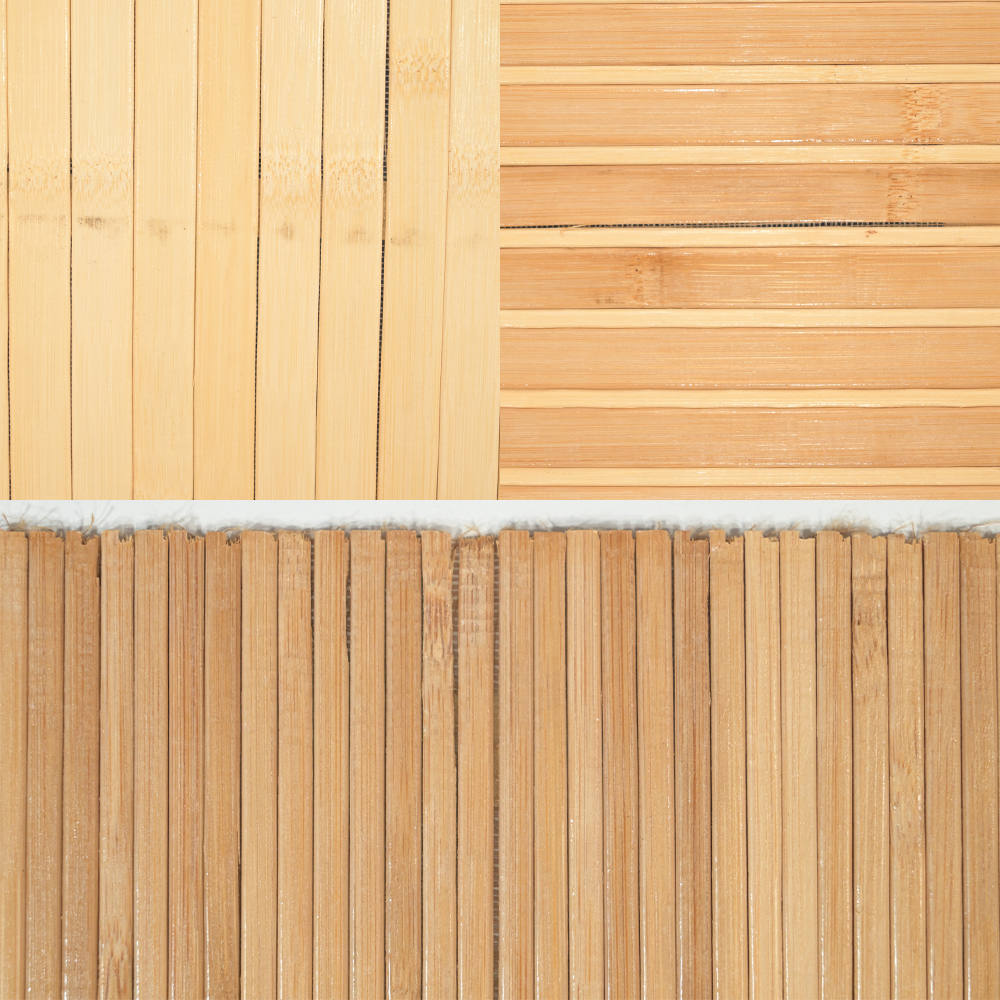
6.1.10 What is the surface treatment of the bamboo wall protection?
Bamboo wall protectors have a natural finish, but there are also finishes with a silk varnish. This is type dependent, not all materials are available in both finishes, but every info can be found on their page on our webshop.
6.2 End caps and splices
6.2.1 What is an end cap for?
The bamboo end cap is used to wrap around the wall protector, covering the edges of the wall protector panel.
6.2.2 What is a splice for?
A bamboo splice is used at the junction of two bamboo panels - the joint. It can be used to cover up any joint defects or as a decorative feature.
6.2.3 In which colours are bamboo end cap and splices available?
Bamboo edgebands and splices are available in light and dark brown.
6.2.4 How to cut bamboo end caps and splices?
They can be cut with a hand saw.
6.3 Custom size blinds
6.3.1 Can I order bamboo blinds in any size?
Basically, yes, but there are a few size limits that should be respected. We can produce rolls up to 240 cm wide (this is the total width of the roll). In length, however, the roll can be any size.
How big bamboo blinds do you need? Measure like this!
6.3.2 What shape can I order?
The bamboo blinds are basically rectangular - standing or lying - but we can also produce slanted blinds for you.
6.3.3 What is a slanted bamboo roller blind?
Slanted blinds usually have a 20% production surcharge. The customer writes the two largest dimensions of the blind on the surface. This will give you an approximate price, which is true 95% of the time. The drawing will be used to confirm the exact price.
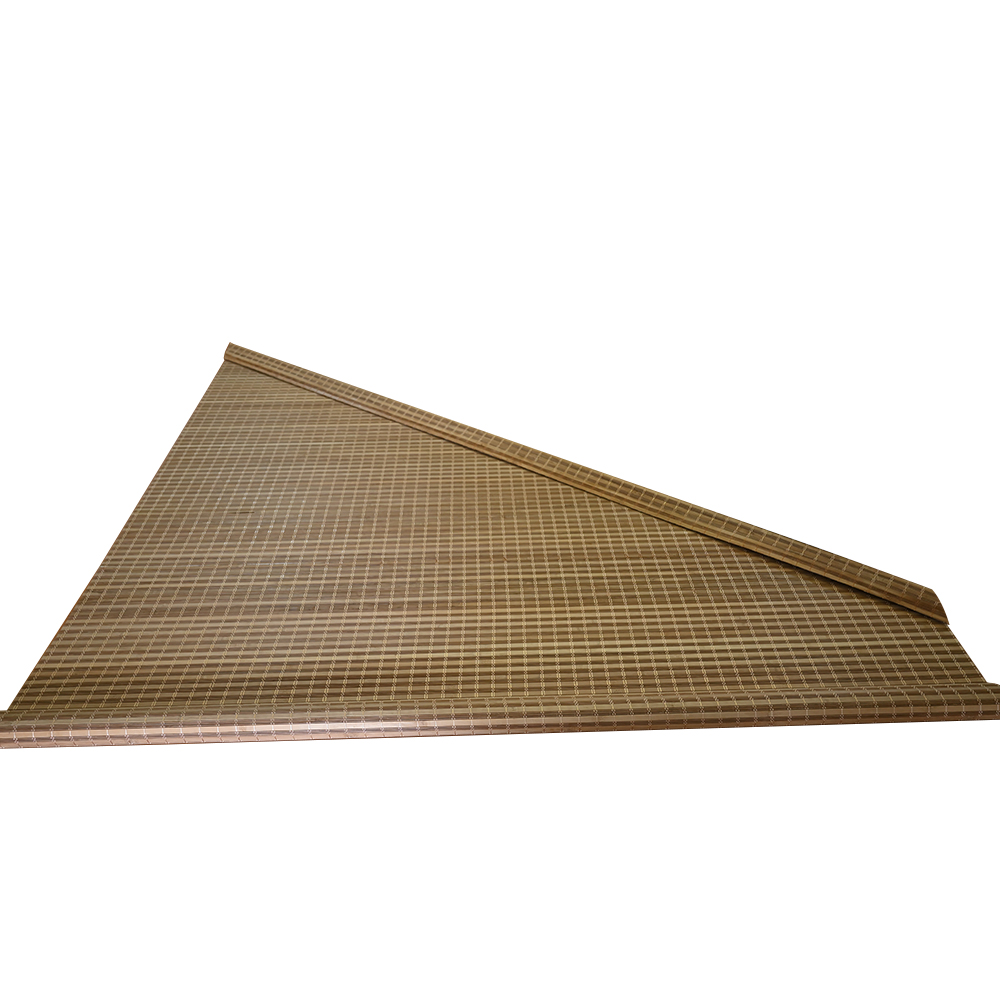
6.3.4 What material can the blind be made of?
Yes, we can make the blind for you from any material. For indoor use any material is suitable. For outdoor use, however, BC-28 and C1C are not recommended.
6.3.5 Which blind material has the best light blocking properties?
The best light blocking performance is BC30. If you want a dark window shade, look for BC30 as the shutter material.
The light blocking ability of bamboo blinds
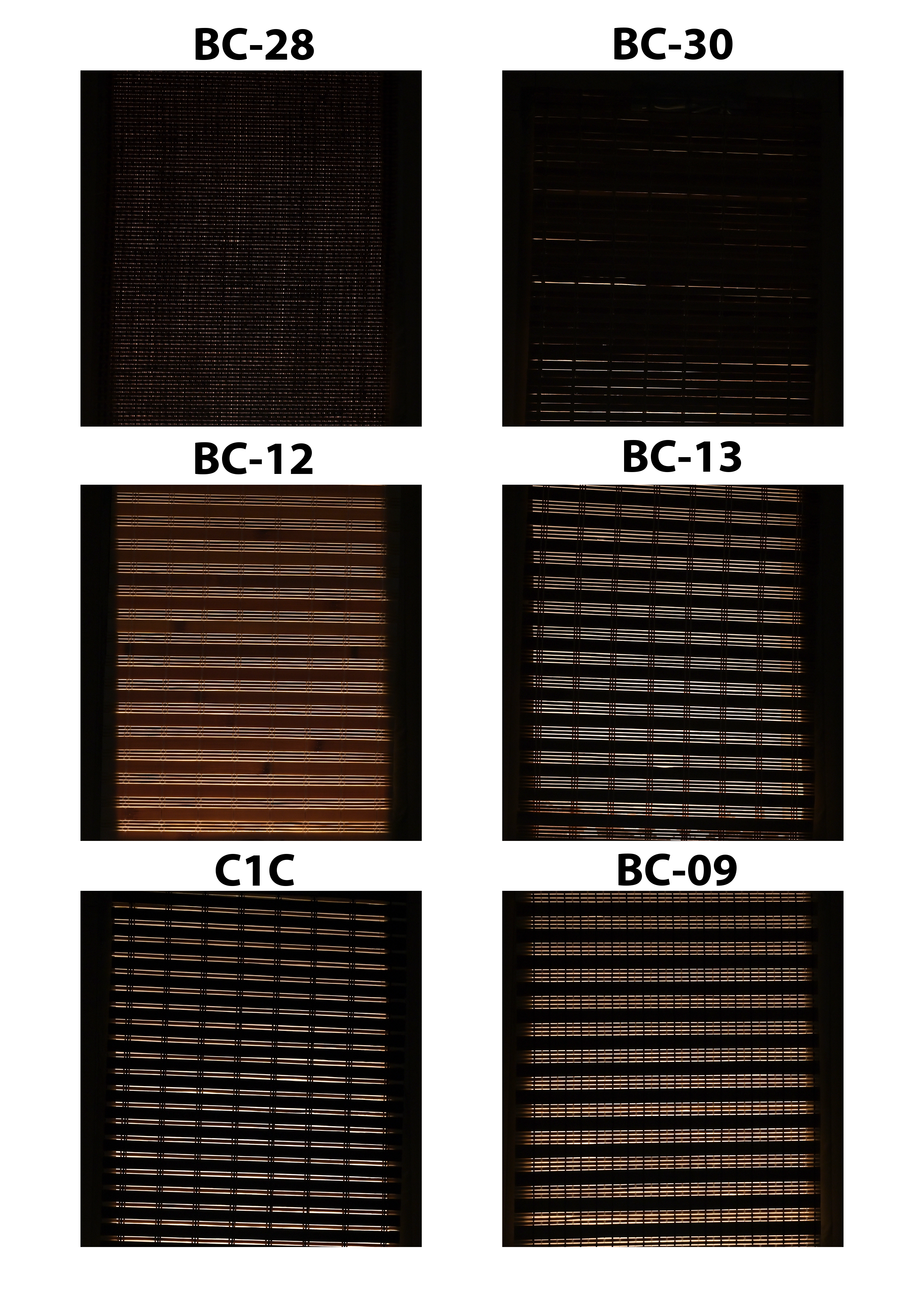
6.3.6 Why is it important to oil outdoor blinds?
It is worth surface treating your exterior blinds! We can treat it with fungicidal wood oil for you if you wish. It is advisable to repeat the oiling every year or two to ensure that your roller blinds can withstand the elements.
How to oil your outdoor bamboo blinds!
6.3.7 What should I do if my bamboo blinds are wet?
If your bamboo blind is wet, wait until it dries. If it is wet, do NOT roll it up.
6.3.8 How do I take care of my bamboo blind?
It is a good idea to coat your outdoor bamboo blind with wood oil every year or two. The blinds can be outside from spring to autumn for patio shading. Remove it during the late autumn and winter rainy season and store it in a dry place.
This is how you should treat the outdoor bamboo blind!
6.3.9 What is the difference between first and second class blind material?
In the case of prefabricated bamboo blinds, our range also includes significantly lower priced 2nd grade bamboo blinds. Features of 2nd grade blinds (one or more will apply):
- variation in length of more than 2 cm per metre.
-The width of the bamboo blinds may vary more than 3mm from the nominal value.
- More than 1 twisted stick per square metre.
- Colour less uniform.
- The slats at the two ends of the slats are not perfectly straight.

Second grade bamboo can also be used as outdoor blinds when properly treated with wood oil.
6.3.10 How do I measure my individual blinds, how big should they be?
To make your custom-made blind, there are just a few things to think about. Depending on the space available, you can choose from four options.
1. Only covers the glass (0,5 - 0,5 cm narrower)
In the case of glass, the size of the shutter should be specified so that it is 0,5 - 0,5 cm smaller than the glass surface, i.e. it does not touch the frame.
2. It also overlaps the window frame (1 - 1 cm beyond the glass)
The other option is to have the shade overlap the frame. In this case, the width of the blind should overhang the glass by at least 1-1 cm.
3. Wall fixing (3 - 3 cm overlap on the window recess, wall)
In this case, 3 - 3 cm overlap should be calculated on the right and left. Thanks to the 3-3 cm overhang, the bamboo blind will completely shade the window as it will cover the entire window, so no light will be filtered in from the sides.
4. In window recesses (1 - 1 cm narrower than the wall)
When fixing in a window recess, the width of the blind should be 1-1 cm smaller than the recess so that the edge of the bamboo blind does not touch the wall.
Make sure that the handle is not in the way, otherwise the blind will stick when lowered.
Choose material like this!
The following should be taken into account when determining the height of the blind:
Type 1G has hangers that are 2.5 cm high, but this is not included in the height of the bamboo roller during production, so for example a 150 cm high roller for Type 1G will have a total height of 152.5 cm if the height is measured from the hanger and not from the top rail.
For type 1G, 2G and 3G, the bamboo blind rolls upwards, so there will be a roll on the window or above it on the wall. The 2R type is a Roman blind, meaning it has a different mechanism, but the material is still getting collected at the top. For this reason, it may be necessary to set the roller higher than originally planned so that this roll does not obstruct the opening of the shutter. This must be taken into account when determining the length of the blind.
6.3.11 What should the mechanics of the blind be?
6.3.11.1 Type: 1G
Traditional bamboo blind. The material rolls up from the bottom upwards, the mechanism is visible. Standard price product. We can safely produce this type of blind up to 180 cm length. Of course, we can also produce longer lengths at the customer's request and responsibility. But in this case we cannot guarantee it!
Bamboo blind with 1G mechanism
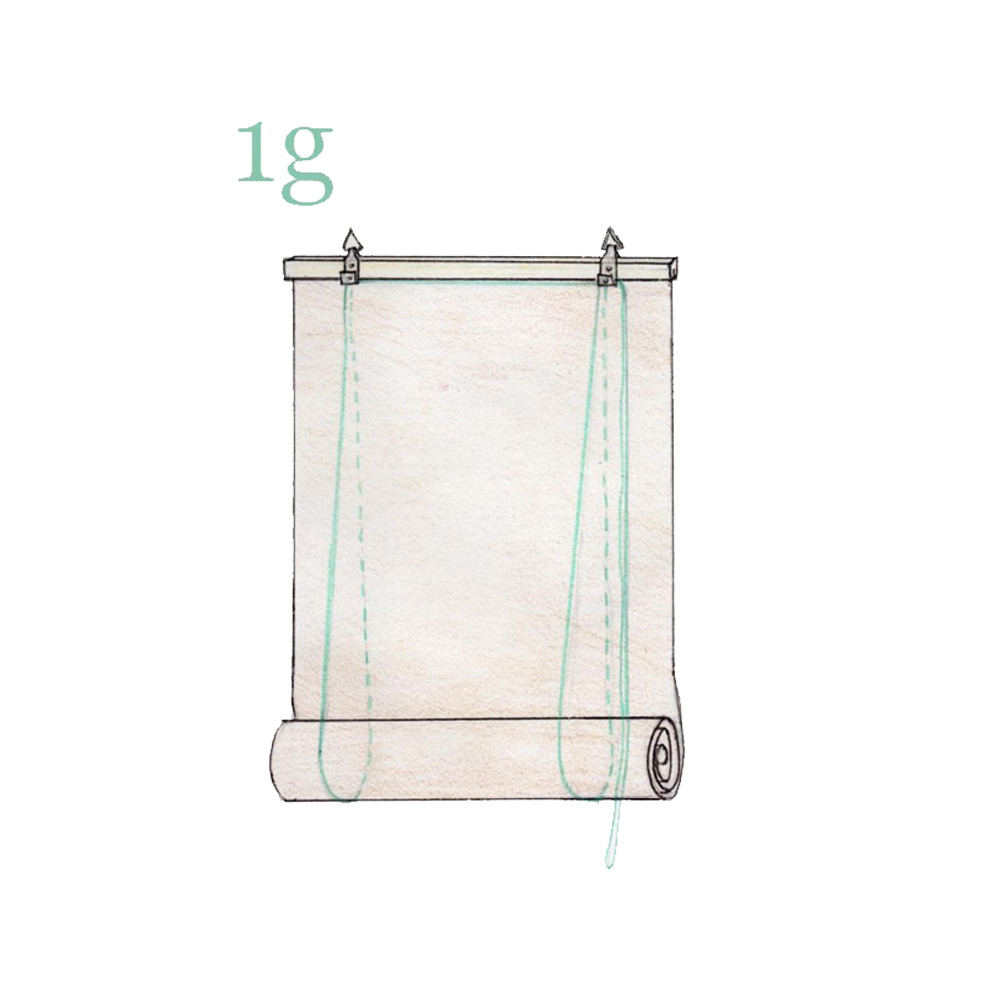
6.3.11.2 Type: 2G
Bamboo blind with hidden mechanism. The material rolls upwards from the bottom. Standard price product. The 10 cm of material covering the mechanism is extra. The winding cord can be on either side.
Bamboo blind with 2G mechanism
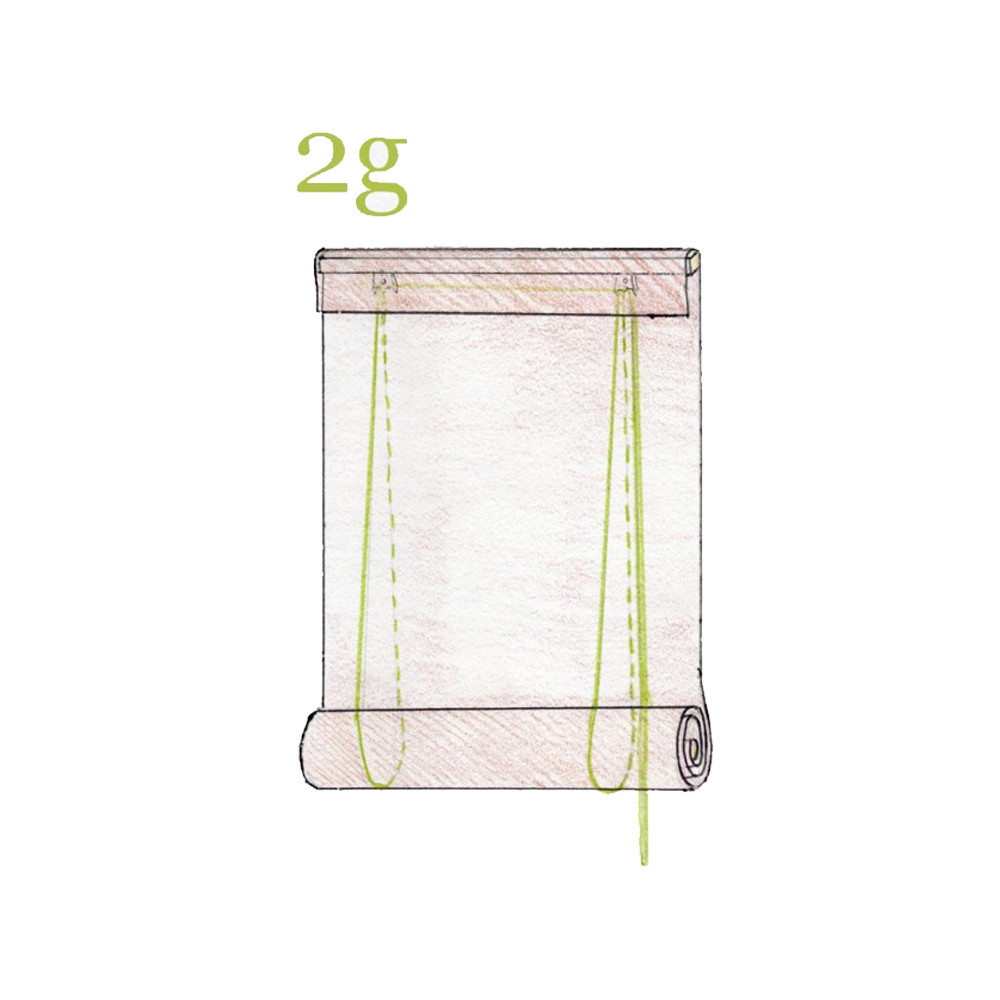
6.3.11.3 Type: 3G
Bamboo rope with reinforced slats, without skirt. The material of the blind rolls from the bottom upwards. Product at basic price. Same as 2g, but without skirt so the mechanism is visible. Also recommended for large extra wide or extra long bamboo blinds and for bamboo blinds with a straight end.
Bamboo blind with 3G mechanism
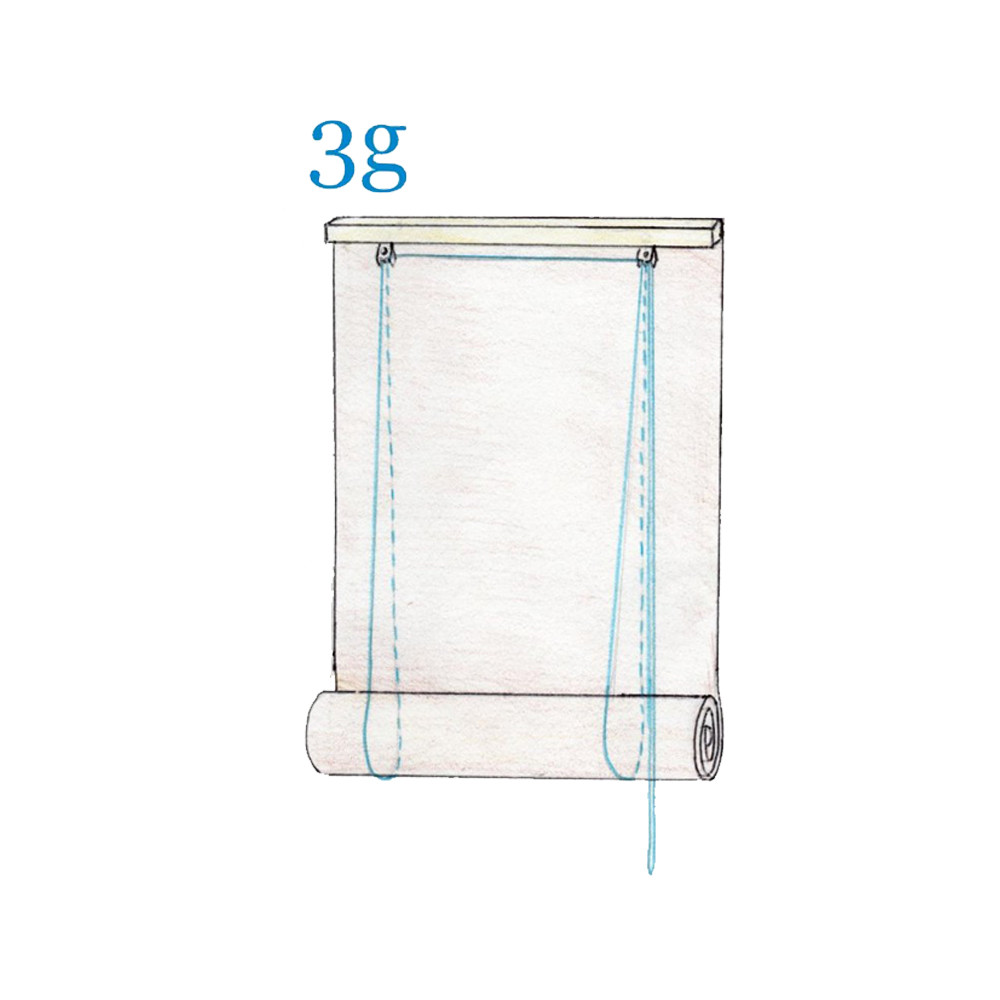
6.3.11.4 Type 2R
Roman blind with concealed mechanism (reefing roll). The bamboo reel material is not rolling but stacking. As the production cost is time consuming, an installation charge of 10% of the basic price is added to the cost of the 10 cm of material covering the mechanism. Both sides can have the winding cord.
Please note: Roman blinds are not recommended for lengths over 1.5m!
Bamboo blind with 2R mechanism
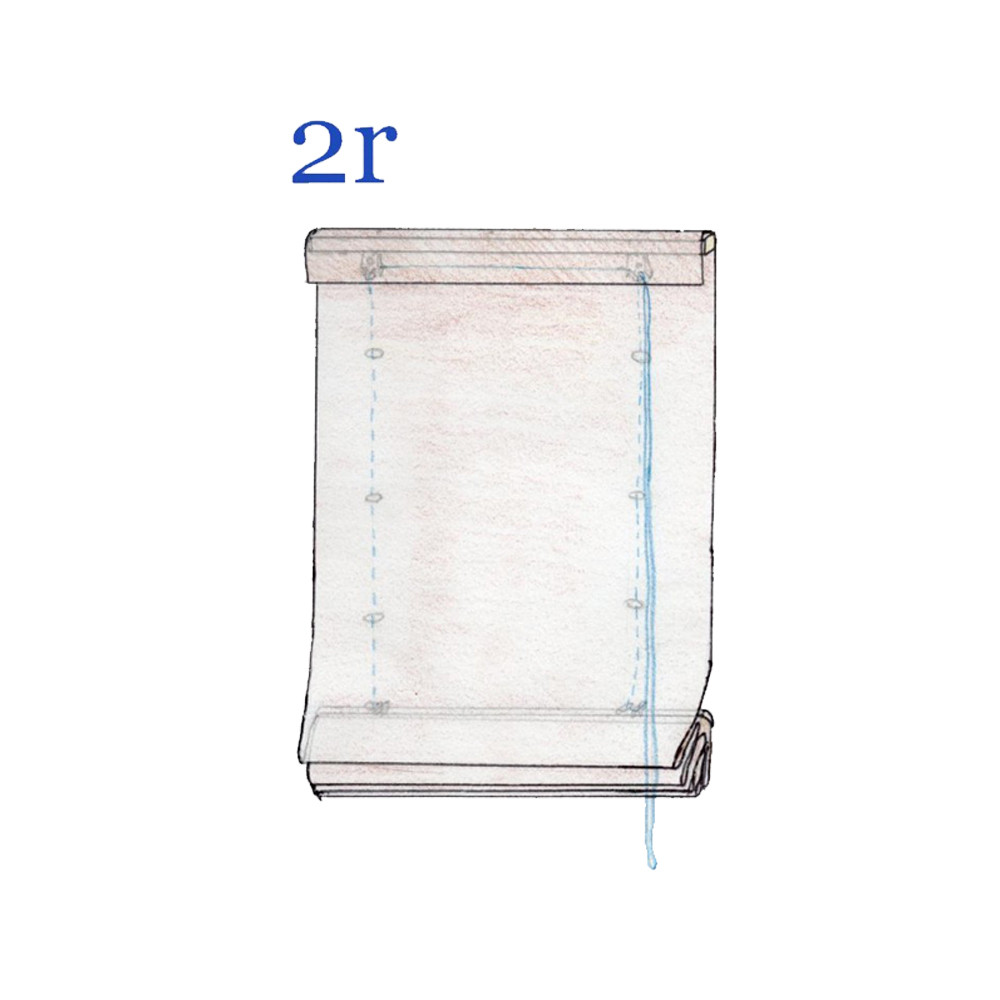
6.3.12 How do I fix the bamboo blinds to the ceiling or wall?
Your new bamboo shutter has arrived, you just need to mount it. We will show you in a few simple steps.
You can choose from three variations to mount it:
On the wall
Ceiling
On a window frame with a screw or a blind fastener
Depending on your choice, you will need a few tools such as a screwdriver, hammer, drill.
The necessary screws and dowels are included in the package.
2G, 2R 3G Mechanical Hanger has two holes on the edges of its top bar. You can fix it to the surface through these holes with through-bolts. There are hooks on the top of the bar on a 1G mechanism reel.
On the wall:
First, fit the blind in place. First, set it horizontally, then mark the holes on the wall.
Make the holes where the markings are. You can also mark the drill stem to ensure that the hole is not deeper than necessary.
Then place the dowels in the holes, hammering a few in place if necessary to get them to fit properly.
Insert the screws into the holes in the two edges of the rods, with the tips slightly overhanging. Insert the screws into the hole and drive them in.
Ceiling:
First, fit the blind into place. Once properly positioned, mark the location of the holes in the ceiling.
Make the holes at the markings. Insert the dowels into the holes, hammering a few into place if necessary to ensure they are properly seated.
Insert the screws into the holes at each end of the blind, with the tips slightly overhanging. Insert the screws into the hole and drive them in.
Fixing bamboo blinds to brick, wood, metal.
6.3.13 How do I fix my blind to a window frame?
There are two types of special designs, ROLKA1 for 1G mechanism roller blinds and ROLKA2 for 2G, 2R and 3G roller blinds.
You will only need a screwdriver for installation.
In both cases, the roller blind fixing bracket must be placed on the top edge of the window.
ROLKA1
Open the roller shutter fixing bracket enough to hook it into the top flange of the window. Fix it with the screws and then snap the plastic cover back on. You can now hang the blind on the bottom hook.
For your 1G mechanical shutter, you can also choose the plastic fastener. In this case, you only have to snap it onto the window frame.
You can also use the metal hook supplied in the package. Screw the two hooks into the window frame and then hang the shutter on them.
Fix it to doors or windows!
ROLKA 2
The installation of ROLKA2 is very simple. You only need to loosen the screwed hardware to adjust the L and U shapes. The L-shaped part goes on the top edge of the window. Once you have it on, just tighten the screw through the mounting hole.
Insert the shutter into the U-shaped part and secure it with a screw through the bottom hole.
Bamboo blind fixer, for doors and windows!
6.3.14 What is the size of the bamboo blind when rolled up?
How much space does the bamboo blind take up when lowered and rolled up? Have a look at the table below, it will help you to estimate if it is correctly measured.
Diameter of the bamboo blind roll.
Height in raised condition including mechanics.
| Blind length | Type: 1G | Type: 2G | Type: 2R | |||
|---|---|---|---|---|---|---|
| 100 cm | 6 cm | 15 cm | 6 cm | 12 cm | 6 cm | 19 cm |
| 150 cm | 7 cm | 16 cm | 7 cm | 13 cm | 7 cm | 20 cm |
| 200 cm | 8 cm | 17 cm | 8 cm | 13.5 cm | 8 cm | 20.5 cm |
| 250 cm | 8.5 cm | 18 cm | 8.5 cm | 14 cm | 9 cm | 21 cm |
6.3.15 How do I fix my bamboo blind to the ceiling?
First, fit the blind in place. Set it horizontally and then mark the holes on the ceiling.
Make the holes where the marks are. You can also mark the drill bit so that the hole is not deeper than necessary.
Then insert the dowels, hammering a few in place if necessary to get them to fit properly.
Insert the screws into the holes in the two edges of the rods, so that the tips of the screws overlap slightly. Fit the screws into the hole and drive them in.
6.3.16 How do I fix my bamboo blind to plasterboard?
First, fit the blind in place. If you have positioned it correctly, mark the position of the holes in the ceiling.
Make the holes for the markings. Insert the plasterboard dowels into the holes, hammering a few into place if necessary.
Insert the screws into the holes in the two edges of the slats, so that the tips of the screws slightly overlap the slats. Fit the slat into the hole and drive the screws in.
Fixing the blind to plasterboard
6.3.17 How do I fix my bamboo blind to wood?
Quite simple! Just place the bamboo shade in place and insert the screws into the holes on the top fixing rod. Screw the screws in.
6.3.18 How do I shade with bamboo blinds if I have a slanted window?
Choose the Naturtrend Impex slanted blind! You only need to specify the dimensions, send us a drawing and we can manufacture the bend blinds. Look under bamboo products/custom made blinds.
6.3.19 How do I shade with bamboo blinds under a glass roof?
There are several possibilities! You can choose to just use a blind material with a batten at the end, or you can use Roman blinds or run the bamboo shade through a wire cord. Essentially, it's a modified bamboo reefing blind. Contact us, we can help!
Retractable bamboo shade under roof
6.3.20 How do I shade a garden gazebo with bamboo blinds?
Nothing could be easier! Buy bamboo blinds made to measure or standard blinds and mount them with screws. It is important to choose a solution that you can remove it in the autumn-winter period. Direct prolonged rainfall can damage your blinds.
Fixing retractable bamboo blind under roof
Wire sliding bamboo shade under glass roof 1
Wire sliding bamboo shade under glass roof 2
6.3.21 How to shade a pergola with bamboo blinds?
For pergola shading you have the possibility to buy bamboo blind material cut to size from us. You only need to fix the cut-to-size material to the roof structure.
6.4 Standard size blinds
6.4.1 What sizes of standard size blinds are available?
Standard size blinds are available in a wide range of sizes. Lengths can be 100cm, 120cm, 140cm, 150cm, 160cm, 180cm, 200cm, 240cm. Width: 90cm, 100cm, 120cm, 140cm, 150cm, 180cm, 200 or 240 cm. Any of the listed sizes can be used in any combination.
6.4.2 What materials are available for our standard size blinds?
The standard size blinds are made of material type BC30 and BC09.
6.4.3 Which mechanics are available for our standard size rollers?
The semi-finished reels are available with 1G mechanism.
6.4.4 How long does it take to produce a standard size roller blind?
Semi-finished rollers are produced in 1 - 3 working days.
6.5 Blind materials
6.5.1 How many different types of blind materials are available?
We currently have 6 different types of blind material to choose from. Each has a different colour and different light blocking properties.
Choose bamboo blind material like this
6.5.2 What is the blind material good for?
Roller blind materials are not only used in the production of roller blinds. They are ideal for many indoor installations. They can be used to make 3d wall panels, partitioning blinds, kitchen door fronts or partitioning screens.
6.6 Leftover blinds, discontinued goods
This category is worth looking at if you need smaller pieces of raw material. There are prefabricated finished blinds, leftover blind materials, but you can also find bamboo wall protectors in this category.
6.7 Blind accessories
6.7.1 What are the different types of blind accessories?
A blind can be used for up to 10-15 years, some parts may need to be replaced. This is typically the blind cord, which can wear out after 2-3 years of heavy use. We also offer blind mechanisms, slats and blind fasteners.
6.7.2 What colours are available for the blind cord?
Three different finishes are available. Cotton material in brown and white and synthetic material in brown.
6.7.3 How do I replace the roller mechanism at home?
You can replace the 1G, 2G, 3G and 2R roller shutter mechanisms at home. Visit our youtube channel. You will find video tutorials on how to replace each of these mechanisms.
Replacing 1G bamboo blind rolling mechanisms
Replacing 2G bamboo blind rolling mechanisms
6.7.4 What are the different methods of fixing the blinds?
There are several methods of fixing your roller blind. We pack a fixing kit for your ordered blind. It includes screws and dowels for wood and wall. If you want to fix your blinds to a window frame or door, choose the ROLKA1 or ROLKA2 blind fixings.
6.7.5 Is it possible to replace the slats holding the blinds?
You can also buy a separate slat for our blinds, but as long as the blind is not damaged, the slat will not need to be replaced. In the case of damage, we have a top and bottom slat to fit the bottom or top of the blind.
6.7.6 How do I replace the blind cord?
The only thing that can wear out during active use is the shutter cord. Replacing them can be done in a few steps, in a few minutes. For more information on how to change the cord, please visit our youtube channel for a video detailing the type of your blind (1G, 2G, 3G, 2R).
1G bamboo shade, cord replacement, rewinding
2G bamboo shade, cord replacement, rewinding
3G bamboo shade, cord replacement, rewinding
7 Carpentry products:
7.1 Marquetry
7.1.1 How is prefabricated marquetry made?
In classic wood inlay, there is a base veneer in which a pattern is cut out and then taken out.
The same pattern is then cut out from a veneer of a different base material and inserted into the base veneer. Both materials are glued to the substrate.
This is not the case here. Here we block together boards of different woods and slice and sand them. Of course, care must be taken to ensure that the blocked materials fit together perfectly.
7.1.2 Why are the inlay strips 0.6 mm thick?
In Europe, 0.6 mm thick veneers are the most common, so it is logical that these prefabricated inlay strips should also be 0.6 mm thick.
If the veneer is thinner and you need to work the inlay strips to match, there's no problem because you can simply sand the two materials together to make them flush. There is also the question of whether it is possible to buy thicker inlay strips. Yes and no.
Thicker inlay strips can be produced, but they will be proportionately more expensive. So, for example, if a 0,6 mm thick strip costs 100 units, a 1 mm thick strip will cost 167 units. In addition, custom thickness inlay strips can only be produced for orders over 1000 m.
7.1.3 How will the fragile inlay reach me safely?
Prefabricated inlay strips are only 0.6 mm thick and are therefore quite fragile. Despite this, no damage from transport has yet occurred.
The one metre long prefabricated inlaid strips are placed in a hard cylinder and shipped in this way.
7.1.4 Is it possible to order inlaid strips with a custom pattern?
Developing a pattern for an inlay strip takes a lot of time and work, so it only makes sense for us to consider designing and producing custom patterned inlay strips for orders over 1000 metres.
7.1.5 How long will it take for the inlay strips to reach me?
We always try to keep 20-30 metres of prefabricated inlay strips in stock per species. This means that in the vast majority of cases, the customer will receive the selected inlay strip within 1-2 working days domestically, 5-7 working days abroad. The longest waiting time (due to stock shortage) we have had in our practice so far was two weeks.
7.1.6 How do I hang inlays at home?
Prefabricated inlay gluing requires few tools. However, it requires a lot of patience and precision. Sand the surface to be glued. Apply wood glue to the surface, spreading it evenly. Place the inlay strip on top and press it down to dry. After drying, sand and apply surface treatment.
7.2 Wooden trellis panels, wood grid
7.2.1 How is a wood lattice panel made?
Wooden trellis panels are made from wooden sticks that are sanded evenly. The sticks are glued together with invisible glue at all points where they intersect.
The surface of the wood lath is unvarnished, so it can still be painted if desired.
They are made of different woods, so you can choose from a variety of colour shades.
If you want to check the quality and colour of the material, you can get free 10 cm x 10 cm samples by post.
These wooden grilles are more suitable for indoor use, as the thickness of a single stick is only 2,5 mm, so the thickness of the whole material is no more than 5 mm.
As this type of lattice is thinner than those normally used outdoors, it can easily be incorporated into any furniture where glass will fit. The grilles are frameless, so they can be installed in all types of furniture doors. Ideal for cabinet door inserts, for example.
7.2.2 Do you also make custom sized lattices?
Made to measure? Yes!
Since our company does not resell but manufactures the wooden lattice itself, it is possible to order not only a standard size lattice, i.e. 65 cm x 125 cm, but also a custom-made wooden lattice. However, as the lattice panels are made using a template, only smaller than standard size pieces can be produced. We can manufacture grids of type APC-01 and APC-03. For the other types we can only cut from the standard board. During the early spring-summer period we cannot produce grids due to seasonal grille production.
7.2.3 Where can I use the diamond trellis panel?
There are many uses for trellis panels, all you need is a little creativity. The most common applications are in bathrooms, hallways and fitted cupboards in kitchens.
It is not uncommon to see darker coloured door frames in cabinets with a lighter coloured lattice inlay, to emphasise the special effect of the trellis wood.
If you want to cover up the radiator in your home because it's old or you simply feel it detracts from the overall look of the room, you can do it beautifully and elegantly with indoor trellis panels. As well as being aesthetically pleasing, the function is not compromised as air can flow freely between the grilles.
It is also important to note that the lattice cannot be used as a fall-arrest device for handrails, as it is not structurally suitable for this purpose. It is also not suitable for covering boilers at a distance where they could catch fire.
7.2.4 What are the materials of which the wooden trellis panels are made?
There are 6 different types of wood to choose from, exotic wood, beech, maple, oak, pine and cherry.
7.2.5 What finishes are available?
There are two finishes, 90' and 45', which which differ in the angle of the grid.
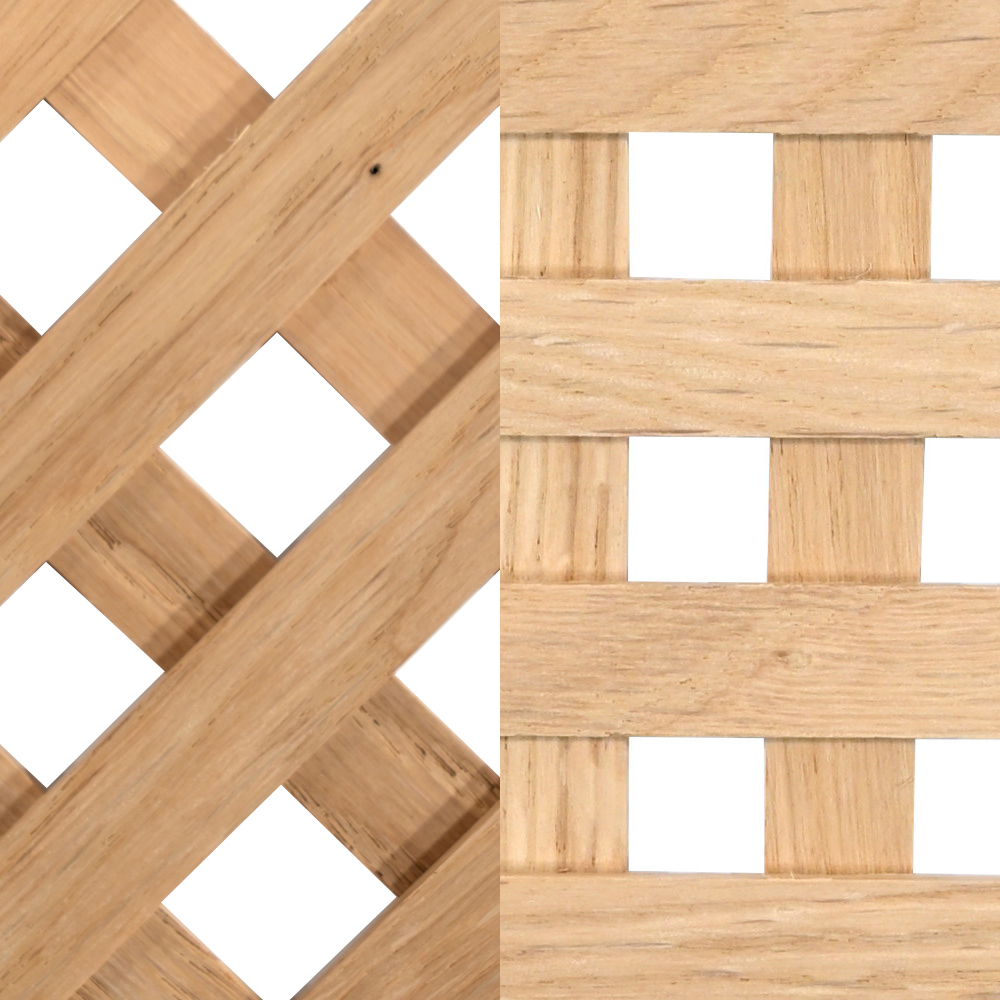
7.2.6 What is the size of the wooden trellis panels?
The total size of the board is 65 cm x 125 cm.
7.2.7 Can the trellis panels be used outdoors?
Yes, it is recommended for indoor use, but after a suitable surface treatment - varnishing, exterior varnish, lacquering - it can also be used outdoors.
7.3 Furniture legs and table legs
7.3.1 What kind of wood are furniture legs and table legs made of?
Furniture legs are available in exotic wood and beech.
7.3.2 What sizes of furniture and table legs are available?
Wooden furniture legs are available from 4.5 cm to 50 cm, depending on the version.
7.3.3 How can I fix the furniture legs and table legs?
Furniture and table legs are generally not drilled, only some types are. Fixing can be done with screws, dowels or glue, it is up to the end user to decide.
7.3.4 Are the furniture/table legs surface treated?
Furniture legs are supplied in a natural finish, so you can decide which surface treatment to apply.
7.4 Carvings
7.4.1 What material are the ornaments made of?
All ornaments are made from wood, including exotic, oak, beech, maple and linden. They come in natural finishes.
7.4.2 What makes an ornament or carving second class?
Minor to major defects can be observed on second class ornaments. These may be wood defects or cracks. Wood defects include discolouration, e.g. where the wood meets the strap. Occasionally a break, where a small piece of the ornament that has broken off. We can also send you a photo of the condition of the second class ornaments on request after ordering.
7.4.3 How do I glue the carved ornament?
Glue the carvings to a wooden surface using wood glue (D2 or D3). Fix, press it to the receiving surface for drying time.
7.4.4 How do I paint the wood ornament or carving?
Carved furniture ornaments are sold in a natural finish. It is therefore up to you to decide how to finish it. You can paint or varnish. You can choose to varnish, lacquer, stain, oil.
7.4.5 How can I repair the wood defect on a second-rate ornament?
Wood defects may occur on the surface of the carving in the case of second-rate products. They can be easily removed with wood filler or wood faget. Putty the defective part, wait for it to dry, sand it. You are ready to paint!
7.5 Moldings
7.5.1 What are the mouldings made of?
The mouldings are made of wood. We offer slats carved from exotic wood, and beech.
7.5.2 What widths are the mouldings available in?
The width of the carved wood mouldings varies, we have mouldings from 0.9cm to 14 cm.
7.5.3 What lengths are the mouldings available in?
Furniture mouldings are typically available in lengths from 125 cm to 250 cm.
7.5.4 Are the mouldings surface treated?
No, they are not surface treated. Painting or varnishing is always at the discretion of the customer.
7.5.5 How do I fix my mouldings?
Wooden mouldings should be glued or nailed! If glued, the use of wood glue is recommended. If you choose nailing, use a small wire nail, as it is thin and will not crack the material.
7.5.6 How do I treat the surface of my mouldings?
Surface treatment of the wooden nailing strip is simple after fixing it to the furniture, sand it to prepare the surface. You are free to paint, varnish or choose other surface treatments.
7.5.7 How do I mitre my wooden mouldings?
Do you want a really nice finish at the end of the skirting board installation? Use a mitre box for cutting! It will help you to cut the wooden skirting board in a regular way.
8 Rattan products:
8.1 Full cane fabric
8.1.1 What can rattan cane be used for?
Rattan fabric can be used primarily for decorative purposes. It can be used as a wall screen, door panel or partition screen. It can also be used in other unusual ways, it's up to your creativity.
Rattan and thonet materials, qualities, which is good for what?
8.1.2 How to work with rattan?
Fixing rattan cane is a very simple task. The rattan cane can be cut with a strong pair of scissors. Before use, it is a good idea to soak it in water for a short time to soften it temporarily. This makes it easier to fix the wet rattan material, e.g. to the door frame. It should not be fixed too tightly, as the material will return to its original size after drying and may tear along the fixings.
8.1.3 How can I get rattan at a discount?
The rattan we offer can be purchased by the metre. It is also possible to order small quantities of rattan. When you buy a whole roll of rattan, we offer you two benefits: firstly, a 10% discount on the price of the product. On the other hand, we will waive the postage costs.
8.1.4 How do I fix the full cane in the frame?
The filled cane fabric is glued to a support material (e.g. backing) and can be placed in the frame together with it. Do not glue with a water-based adhesive, as wet cane fabric will stretch. When it dries out it will deform the substrate. Use e.g. silicone for gluing, which should be pulled apart with a comb spatula. The material should be weighted down while it dries.
8.1.5 How do I make a well ventilated door for a cupboard?
The secret to a well-ventilated cupboard door is the right inlay material. Choose from our range of thonet material, rattan wicker or cane for your wardrobe.
8.1.6 How to glue the cane fabric?
Do not use a water-based adhesive. Either silicone or contact adhesive.
8.2 Thonet fabric, wicker
8.2.1 What is thonet fabric made of?
The rattan cane fabric we offer is made from natural materials.
Rattan, also known as rattan palm, is a fast-growing, liana-like creeper plant native to the rainforests of South East Asia. It can grow lianas up to 200 metres long, some up to 5 cm in diameter. Rattan is one of the longest plants on Earth. But we also have paper-based rattan materials on offer. The material with the sign PTH is a recycled paper-based fabric.
8.2.2 What is the difference between thonet fabrics marked S, G, N, D?
S is superior. It is the best quality for chair seats as it is a heavy duty material.
The G grade is almost identical to the S grade. The only difference is that it is darker and more affordable.
The N grade is slightly weaker, but just as nice. It is perfect for less demanding surfaces, such as chair backs and inserts.
The D material is cellulose based and has a very nice and even surface. Only suitable for decorative work. It can be used to make radiator covers, door inserts or partition screens.
Difference between the thonet materal qualities? Click on the video!
8.2.3 What widths of thonet reed can be purchased?
Thonet materials are supplied in rolls of 15.24 m in length. They are available in widths of 45, 50, 60 or 90 cm.
8.2.4 Are there different thonet materials with different hole sizes?
There are several types of hole sizes. We basically have ½ hole size materials in stock. We keep a width of ⅝ hole pitch material for repair purposes.
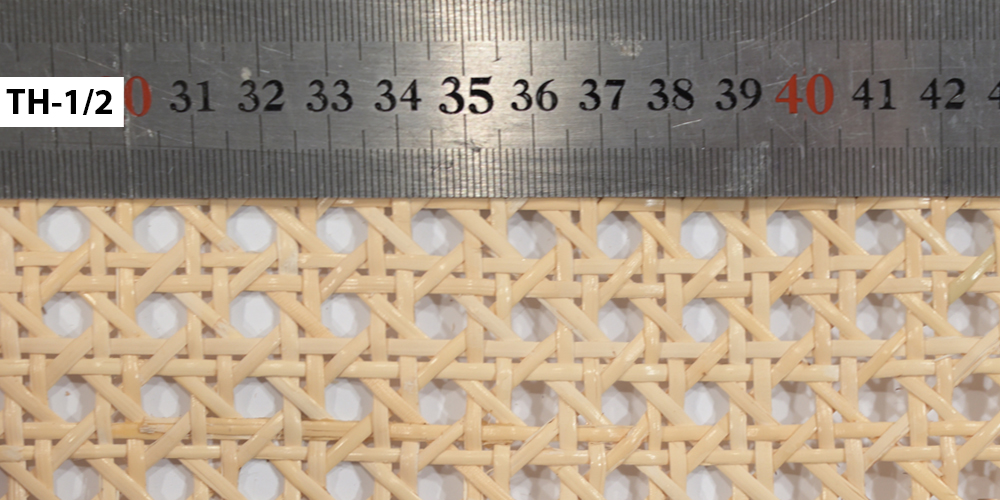
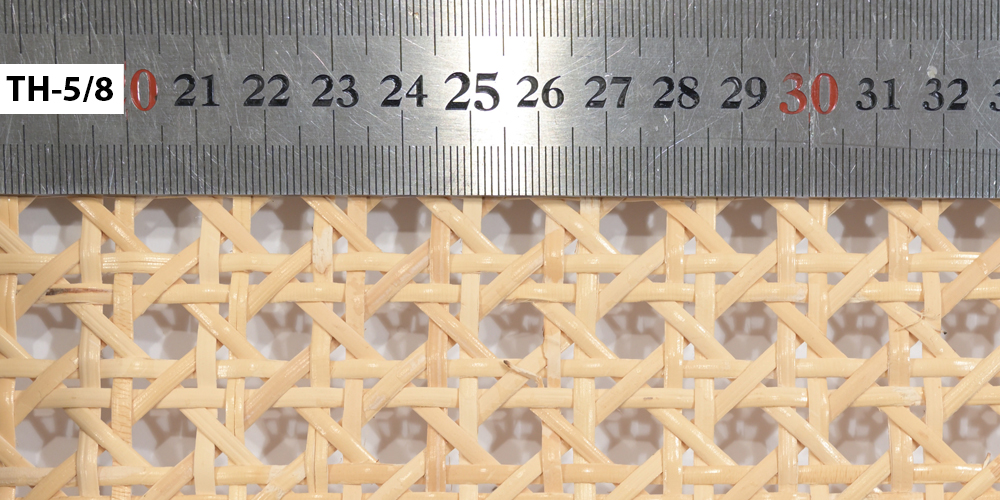
8.2.5 Is there a roll discount for thonet material?
Yes! If you buy a whole roll or more, we will give you a 10% discount and free shipping within the EU.
8.2.6 How do I fix the thonet fabric in a frame?
A stapler is sufficient for framing. With this you can even mount it at home.
The thonet fabric softens and stretches slightly when exposed to water, making it easy to handle. It is therefore advisable to soak it in cold water for half an hour before fixing, and then (before it dries) to staple it tightly to the wooden frame (on the inside).
Do not fasten too tightly, as the material will return to its original size after drying and may tear along the fastenings.
8.2.7 How do I make a well ventilated door from thonet fabric?
Thonet fabric can be used as a door inlay in furniture or as a wooden frame to conceal light fittings, radiators and radiators as it does not obstruct the air flow.
Thanks to its design, air can flow freely through the perforated thonet fabric, yet it conceals enough air to keep radiators, for example, out of sight. Its ventilation function can also be put to good use in hall closets or shoe cupboards.
8.2.8 Can rattan be used in wet environments?
Yes, artificial rattan cane can be used in wet environments, e.g. bathrooms.
8.2.9 Is artificial rattan easy to clean?
The artificial rattan cane fabric is not a problem if it accidentally gets dirty. It can be easily cleaned with a wet, mildly detergent cloth.
8.2.10 How can I fix the black artificial rattan cane?
The artificial rattan cane can be fixed with a hand stapler when used as an inlay.
8.3 Reed, rattan stick
8.3.1 What is a reed and what can it be used for?
Our reed is actually made from rattan (rotang palm, Spanish cane), a typical creeping-stemmed liana plant of tropical rainforests. It can be used for wicker chair repair, thonet chair refurbishment, but it can also be used to make perfumed sticks and karate sticks.
8.3.2 What is a rattan stick?
A rattan stick is essentially a piece of rattan palm cut to size and peeled.
8.3.3 What are rattan sticks and rattan poles used for?
Used in the furniture industry, for furniture frames, e.g. garden chairs. But rattan sticks are also used as weapons in martial arts. It is light, strong and flexible.
8.3.4 What is reed?
The reed is made from rattan, a tropical creeper. The rattan plant is drawn through a special circular knife which gives the final stick, cylinder shape. It’s length is typically above 2,5 m.
8.3.5 What is a reed stick for?
It can be used for a number of things. It can be used to make wicker furniture or other objects. But it can also be bought as a perfuming stick. Craftspeople make a whole range of do-it-yourself creative ideas from the material.
8.3.6 How many meters of material are there in 1kg of reed?
| Diameter | Meter per kg |
|---|---|
| 1.5 mm | 904 |
| 2 mm | 562 |
| 2.5 mm | 402 |
| 3 mm | 337 |
| 4 mm | 147 |
| 5 mm | 107 |
| 8 mm | 42 |
| 10 mm | 24 |
8.3.7 What sizes of rattan sticks are available?
The rattan stick is sold in lengths of 70 cm, 150 cm and 190 cm. Other sizes can be cut on request.
8.3.8 In what size is the pre-cut rattan evaporator stick available?
Rattan sticks are available in 20 cm, 25 cm and 30 cm sizes, with a diameter of 3 mm
8.4 Spinning and tying thread
8.4.1 What is braiding and tying thread made of?
The raw material for rattan cane or tying thread is rattan, also known as rattan palm, which grows by creeping on the ground and trees in shady rainforests. It develops a longitudinal fibrous stem under a strong bark, which can reach 200-300 metres in length. Very strong and flexible.
8.4.2 How many metres of material are there in 1 kg of rolls of chair cane?
I am not giving this in metres, as that only raises another question. A bundle of material can be used to weave the seat and back of a standard dining chair.
8.4.3 What can be made from the cane?
It can be used to weave baskets and other ornaments, or for weaving garden furniture.
8.4.4 How can rattan fibre be used?
Soak the rattan fibre before use. This will make it flexible and prevent it from breaking. It can be used for making cane furniture, basket weaving and weaving ornaments.
9 Chair repair:
9.1 Do we provide quality thonet chair repair and refurbishment?
We can professionally repair both hand woven and grooved thonet chairs. We repair hand woven (round hole) thonet chairs using the original technology. We undertake the repair of hand-spun (round hole punched) tonet chairs per square centimetre spun. For tonet chairs with a groove, the length of the groove in the circle determines the cost of the repair.
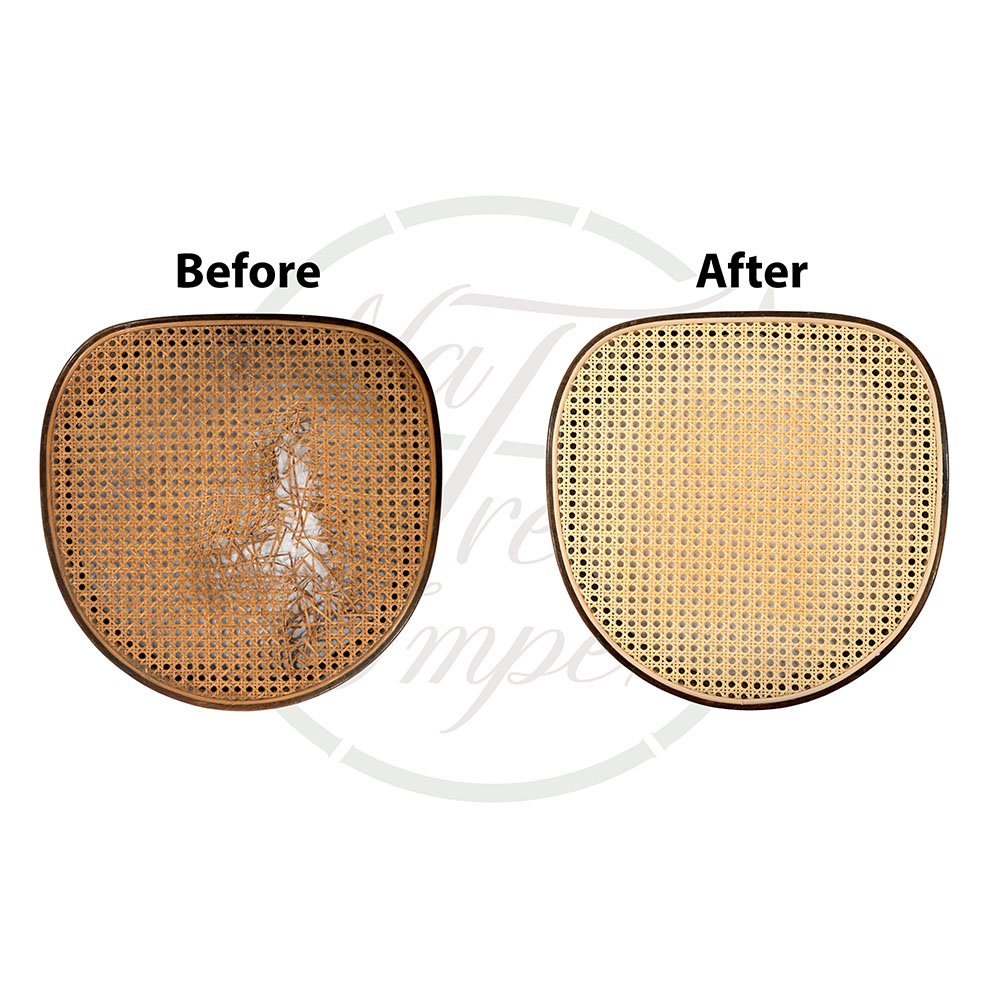
9.2 How do I know if my thonet chair is grooved?
In the grooved type, a groove (a U-shaped recess) is cut into the edge of the seat of the chair and the pre-cut rattan cane fabric is inserted into it, with a cane padding.
9.3 How do I know if my thonet chair is handwoven?
A hand-woven thonet chair has holes around the perimeter, and the rattan thread is woven into these holes.
9.4 How do I know if my thonet chair can be repaired?
Take some photos and send them to munka@naturtrend.com and our colleague will answer your question shortly.
9.5 How is the thonet chair repaired?
All thonet chair repairs are fully refurbished by our experts using the traditional hand method. We will include your chair in our existing work and complete it in 2-3 weeks.
9.6 Should I send my thonet chair for refurbishment disassembled?
Yes! If it arrives by post or by courier. Send only the surface to be repaired, not the complete chair.
9.7 Can I send the thonet chair by post or courier?
Yes! There is also the possibility of delivery and return.
9.8 What materials fit the thonet chair?
The materials with S and G markings are perfect for sitting surfaces for chairs.
9.9 How much does it cost to repair a thonet chair?
Basically it depends on the size. Ask for the price by email.
9.10 How can I order a repair for my thonet chair?
Contact us at munka@naturtrend.com. Our staff will be happy to help you with any questions you may have.